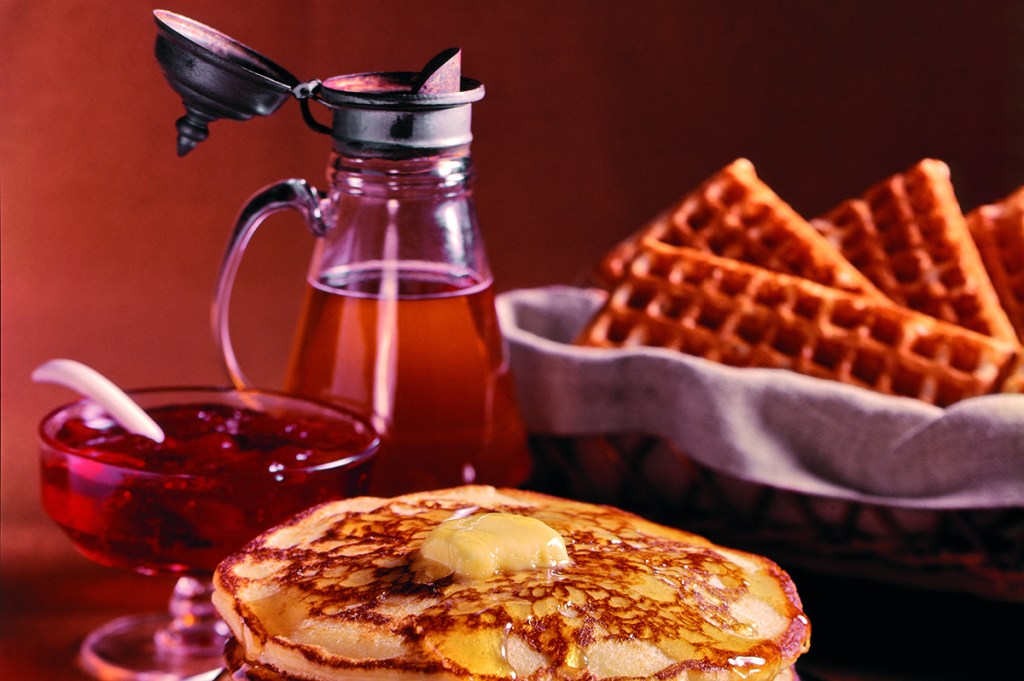The decline and fall of the New York Times, like that of the Roman Empire, did not happen overnight. Believe it or not, by 1970 the rot had already set in at the Times and rank error was being peddled as fact to a trusting public. I have proof.
In August of that year, the paper ran a review of a Canadian theatrical production just arrived in New York called ‘Love and Maple Syrup’ (a reference to a Gordon Lightfoot song). The show was panned — so far, so par for the course — but the review ended on a shockingly error-riddled and un-factchecked note: ‘Love, incidentally, is great, but have you actually tasted maple syrup? Ugh! Only a nation with built-in insecurities and a dire need for blood sugar could have chosen it as its national drink.’
Right there, folks. You noticed that casual bending of the truth, done so naturally, a mere flick of the wrist in passing? That’s what you call the beginning of the end. Alas, poor Times, we knew ye well. All the fiction that’s fit to print. Where’s Snopes when they’re wanted? I detect — let me count them — one, two, at least three falsehoods.
First of all, maple syrup is not a drink. You can put it in drinks — with whiskey and Angostura bitters, for instance — but it is not per se a drink. This is an error commonly encountered on the Continent, where they like to pour a dash of fruit syrup into a glass of water as flavoring. No self-respecting Canadian, or American for that matter, would pour maple syrup into a glass of water and drink it. You could, in a moment of weakness, drink unadulterated maple syrup, it is true. But that doesn’t make maple syrup a drink any more than using a spoon to eat Nutella makes it breakfast.
Secondly, this calumny against the taste of maple syrup can’t be left unchallenged. Maple syrup is delicious. Let us set aside the cliches about pancakes and waffles and bacon, and turn to hard scientific fact. What makes maple syrup taste good? It’s the Maillard reaction, of course — the chemical reaction that makes grilled steak good and puts the fry in French fry. The Maillard reaction causes browning, produces flavor and aroma, and makes food more appealing and more digestible. Freshly baked bread loaves owe their golden crust and their delightful smell to the Maillard reaction; it brings out the best in toasted hazelnuts and roasted coffee beans. It’s what happens when amino acids and reducing sugars interact in the presence of high heat, and it makes everything better: crispier, browner, more flavorful.
What has all this to do with maple syrup? Well, syrup is made by boiling down maple sap, collected during sugaring season in picturesque buckets for small operations, or somewhat less picturesque vacuum lines running from tree to tree in larger operations. The sap is made up of water, minerals, sugars, organic acids, nitrogen compounds and, like red wine, phenolic compounds and flavonoids. When the sap is subjected to high heat during the evaporation process, both the Maillard reaction and the caramelization process — the breaking down of complex sugars at high heat — kick in. The syrup darkens, thickens and acquires a nutty flavor. The amino acids and reduced sugars get chummy, and flavors and aromas start to bloom. This results in a flavor profile and bouquet that is unique to the specific terroir of the sugarbush, because the specific composition of the sap depends on the tree, the day, the soil and the climatic conditions.
While sap varies even among sugar maples in a given bush, it varies even more from one region to the next, meaning that maple syrups from different regions possess their own distinctive characteristics. Professional tasters talk about dominant roasted, woody, or vanilla flavors; degrees of confectionery; and minor flavors pertaining to fresh herbs, cut grass, nuts, dairy, spice and flowers.
Another flavor tasters can detect is umami — a newfangled expression for the basic, satisfying taste of savory food. Perhaps this is why maple syrup pairs so well with meat and vegetable dishes, such as spring lamb roasted with maple syrup, or glazed carrots. You’ve got to use the real stuff, though, no nasty synthetic imposters. Seafood does well with maple too: try maple-seared scallops with blood orange and fennel salad.
Umami is a Japanese word that means something like deliciousness, and maple syrup is increasingly popular in Japanese cuisine. Its chemical composition overlaps with soy sauce, which makes them soulmates in the saucepan (not to mention the roasting pan). You’ve surely enjoyed soy-maple chicken or salmon; if not, do me a favor and rush to the kitchen to try it. You won’t be disappointed.
Outside of North America, Japan is maple syrup’s biggest consumer. The biggest syrup-producing region in North America is Québec, though other regions are starting to step up production in response to rising international demand. Part of the Québec formula is the Federation of Québec Maple Syrup Producers, a body (say the charitable) or cartel (say the uncharitable) which regulates all syrup production and marketing in the province via a quota system and what it grandly calls the International Strategic Reserve.
All of Québec’s commercial maple syrup producers must buy according to the quota and sell their syrup at fixed prices through the Federation. Excess syrup is stashed in the International Strategic Reserve, and producers only get paid if and when the syrup is sold. This has the salutary effect of insulating the market against the rollercoaster effect of fat years and lean years (a real issue in such a weather-driven, seasonal industry). On the downside, it’s illegal to sell your own syrup commercially without going through the Federation, and heavy fines are handed out to producers caught dabbling in the black market. Some find this saps their enthusiasm for the business.
In 2011, disgruntled syrup traders began the Great Canadian Maple Syrup Heist, a Canadian crime that, like the syrup itself, is almost too good to be true. Thanks to an inside man, a creative smuggler figured out how to tap into the International Strategic Reserve. Working in the dead of night, he would haul white-oak syrup barrels from a Reserve warehouse to an accomplice’s sugar shack out in the woods, where his allies helped him siphon out the syrup. Then they refilled the barrels with water from a nearby pond and replaced them in the warehouse, still under cover of night. The repackaged syrup was trucked over the Québec border into New Brunswick or Vermont and sold as legal syrup, out of reach of the long arm of the Federation.
It was a sweet gig while it lasted. The smugglers made off with over $15 million in syrup. But for some reason they got careless. They stopped refilling the barrels with water. Maybe the pond ran out, or the pump froze — these, after all, are the hazards of the Canadian backwoods. When inventory time rolled around, the Federation inspector was climbing up a stack of barrels in the warehouse and nearly fell when the empty barrels at the top overbalanced. The game was up.
‘People come and stand in line to rob the forest of her wine,’ sang Gordon Lightfoot in ‘Love and Maple Syrup’. Some rob the forest, some rob the robbers. Surely all is fair in love and syrup wars. But the Mounties, who always get their man, disagree.
This article was originally published in The Spectator’s March 2021 US edition.

























